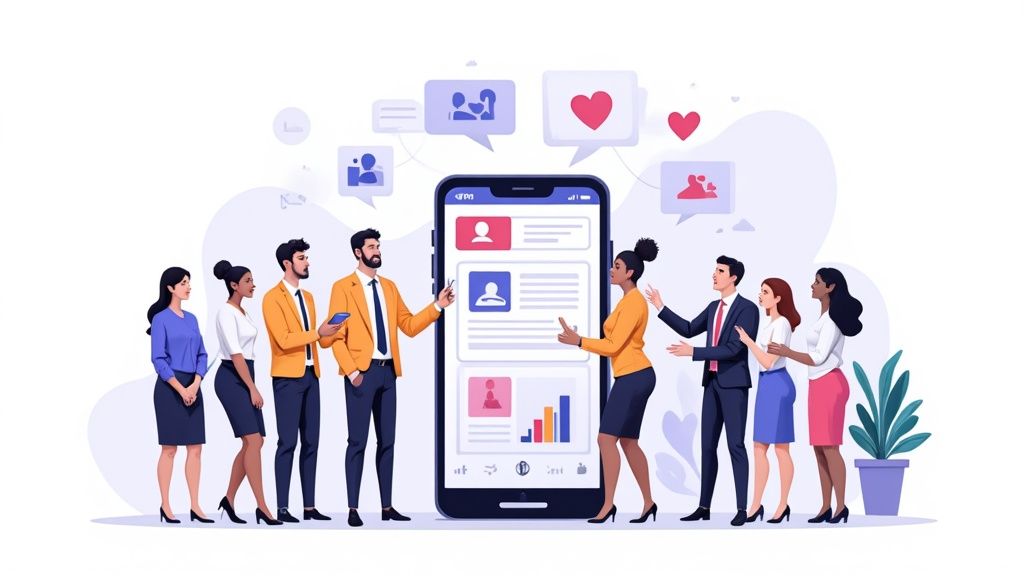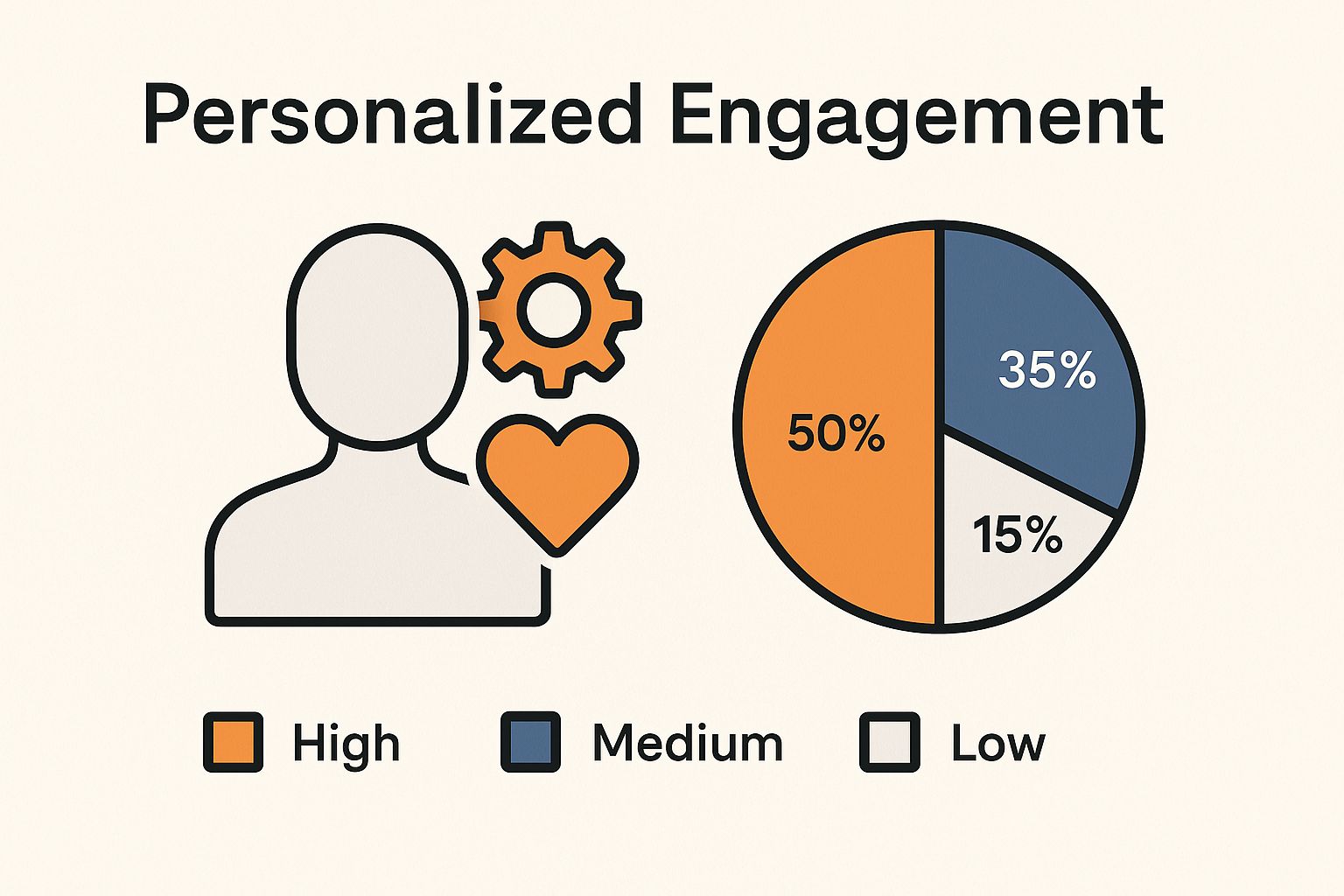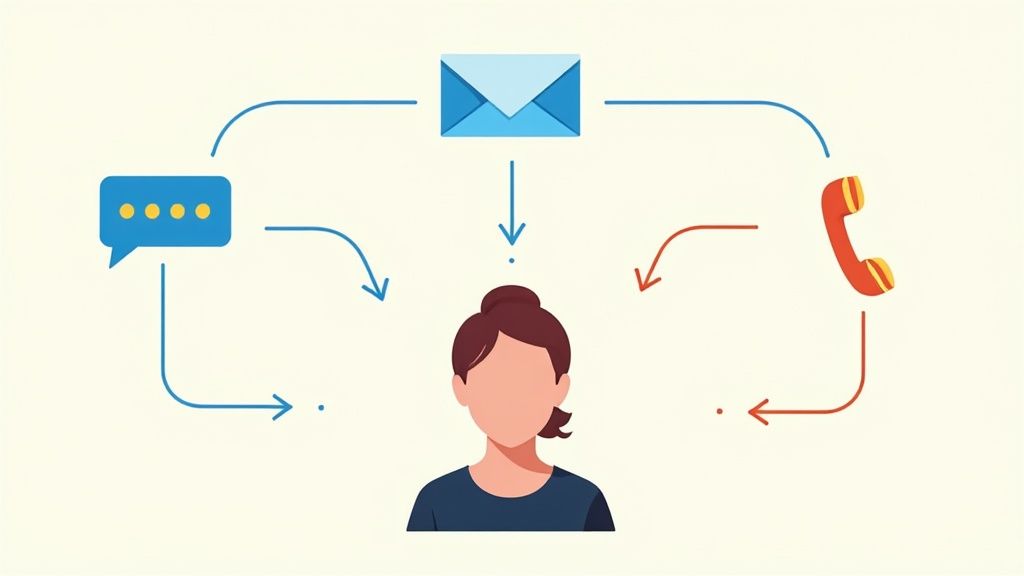How to Improve Customer Engagement: Proven Strategies That Work

If you want to grow, you have to stop thinking about one-off sales and start building real, lasting relationships with your customers. It's a fundamental shift, but it's essential. This means getting personal, staying in touch consistently across all your channels, and using the right tech to figure out what your customers want before they even ask for it. The whole point is to make every single interaction feel like it matters.
Why Customer Engagement Is Your New Growth Engine
Let's be honest, in today's crowded market, brand loyalty is on thin ice. Customers have endless options, and one bad experience is all it takes to send them running to your competition. That's why the smartest companies are changing their tune. They're realizing that the biggest opportunity for growth isn't chasing new leads—it's right there in their existing customer base.
Real growth isn't just about getting new people in the door. It's about turning the customers you already have into your biggest fans.
This means putting customer retention at the heart of your business. Why? Because engaged customers do more than just stick around—they spend more. In fact, studies show that companies that really nail the customer experience see a 4-8% revenue boost over their rivals. That's because an engaged customer feels seen and valued, not just like another entry in your CRM.
From Transaction to Relationship
The secret to unlocking this kind of growth is a simple change in perspective. Stop looking at customer interactions as isolated events. Start seeing them as part of an ongoing conversation. Every email, social media comment, or support ticket is another chance to make that connection stronger.
This isn't about spamming them with marketing messages. It's about delivering value when it counts. For instance, instead of blasting out a generic "20% off" coupon, why not send a personalized offer for a product they were just looking at? Or maybe a helpful guide related to something they recently bought? To do this effectively at scale, you'll want to explore different customer engagement solutions that can help you automate and personalize these moments.
The brands that are winning today get it: customer engagement isn't just another marketing play. It's the whole strategy. It’s about building an emotional bond that turns a one-time buyer into a loyal advocate for life.
The Foundation of Modern Engagement
You can't build these connections on a shaky foundation. Get these fundamentals right, and even your simplest campaigns will hit the mark.
- Authentic Communication: Talk to your customers like they're people, not targets. Drop the corporate-speak and be upfront, especially when you mess up.
- Actionable Feedback: Don't just ask for feedback—do something with it. When customers see you implementing their suggestions, it builds incredible trust because it proves you're actually listening.
- Smart Technology: Use tools to see what your customers are doing. This lets you personalize their experience and show them you understand their unique needs, moving way beyond guesswork.
By focusing on these core elements, you're not just building a strategy to keep customers around. You're laying the groundwork for sustainable, long-term growth that will set your business apart.
Measuring the Engagement That Actually Matters
If you want to genuinely improve customer engagement, you have to start by measuring what actually matters. Relying on vanity metrics like social media likes or page views is like judging a book by its cover—it might look good, but it tells you nothing about the story inside. The real goal is to track the actions that signal true interest and long-term loyalty.
This means shifting your focus to performance indicators that tie directly to business goals. Think less about fleeting praise and more about sustained behavior. Are people coming back for more? Are they really digging into your product and using its features? Are they telling their friends about you? These are the questions that unlock meaningful insights.

As the image shows, successful engagement is a blend of smart optimization (the gear) and real human connection (the heart). When you get both right, you create a far more valuable experience for your customers.
To help you get started, here are some of the most critical metrics you should be tracking. These numbers paint a clear picture of your customer relationships and their overall health.
| Key Metrics for Measuring Customer Engagement | | :--- | :--- | :--- | | Metric | What It Measures | Why It's Important | | Customer Lifetime Value (CLV) | The total revenue a single customer is expected to generate over their entire relationship with your brand. | A rising CLV is a fantastic sign that your engagement efforts are working. Happy, engaged customers stick around longer and spend more. | | Net Promoter Score (NPS) | Customer loyalty and satisfaction, gauged by asking how likely they are to recommend your product or service. | This is a simple yet powerful way to measure overall sentiment and pinpoint your most enthusiastic brand advocates. | | Feature Adoption Rate | The percentage of users who are actively using specific features of your product or service. | Low adoption can highlight issues with user experience or a lack of awareness, showing you exactly where you need to improve or educate. | | Churn Rate | The percentage of customers who stop doing business with you over a specific period. | This is a direct measure of customer retention. High churn is a major red flag that something is wrong with your engagement strategy. | | Session Duration & Frequency | How long users spend on your app or site during a single visit and how often they return. | These metrics indicate how captivating your experience is. Longer, more frequent sessions suggest users find real value. |
Keeping an eye on these KPIs helps you move from guesswork to informed action. They provide a solid, data-backed foundation for every strategic decision you make.
When Bain & Company asked organizations to rate their quality of customer experience, 80% believe they are delivering a superior experience. This is compared to only 8% of customers who believe they are receiving a great customer experience.
That’s a staggering gap. It perfectly illustrates why objective measurement is so vital. Without it, you’re essentially flying blind, likely overestimating your performance while missing huge opportunities to connect with your audience.
Turning Data into Actionable Strategy
Once you’re tracking the right metrics, the real magic happens when you use that data to segment your audience. Not all customers behave the same way, so why treat them that way? By grouping them based on their actions, you can craft highly targeted strategies that feel personal and relevant.
For instance, you could create segments for:
- Power Users: These are your die-hard fans—your most active and loyal customers. Keep them engaged with exclusive content, early access to new features, or loyalty rewards to transform them into powerful brand ambassadors.
- Occasional Users: This group might just need a little nudge. Re-engage them with helpful tutorials, shine a spotlight on features they haven’t discovered yet, or send personalized offers based on their past activity.
- At-Risk Users: Customers whose activity is dropping off are a major red flag. Don't wait for them to leave. Reach out proactively with a quick survey or a special offer to understand their pain points and win them back before they churn.
This segmented approach allows you to tailor your communication so that every message feels like a one-on-one conversation, not a generic broadcast shouted into the void.
Creating Personalized Experiences That Build Loyalty
Let's be honest, personalization isn't just a "nice-to-have" feature anymore. It’s the very foundation of modern customer engagement. Today’s customers have come to expect that the brands they interact with actually understand their individual needs and what they're looking for.
When you deliver an experience that feels genuinely tailored to someone, you do more than just make a sale. You start building a real connection—the kind that turns a casual shopper into a loyal fan who tells their friends about you.
This all starts with your data. By looking at a customer’s purchase history, how they browse your site, and their past interactions, you can finally move beyond those generic, one-size-fits-all messages. Instead of another email blast that gets ignored, you can send targeted offers for products they’ve actually shown interest in. That simple shift makes your communication feel less like an ad and more like a genuinely helpful recommendation.

Using Data for Authentic Connection
The real trick is using data to provide genuine value. Think about Netflix’s recommendation engine or the Discover Weekly playlists from Spotify. These features are so effective because they analyze your past behavior to suggest new content you'll probably love. It's a classic win-win: you discover something new, and the platform deepens your engagement.
You can apply that same thinking to your own business.
- Dynamic Website Content: Why show the same homepage to everyone? You can display different banners or product recommendations based on whether a visitor is new or a regular.
- Segmented Email Campaigns: Group your customers by how often they buy. You could send a "we miss you" offer to someone who hasn't purchased in six months, while a frequent buyer gets a sneak peek at a new collection.
- Personalized Social Media Ads: Use remarketing to show ads for the exact products a user viewed but didn’t buy. It’s worlds more effective than a generic brand ad.
These tactics show your customers you’re paying attention. For more ideas on how to apply these principles on professional networks, check out our guide on how to get more engagement on LinkedIn.
The Power of Data-Driven Loyalty Programs
A well-designed loyalty program is one of the most powerful tools in your engagement arsenal. It goes way beyond just offering discounts; it creates a system where customers are actively rewarded for sticking with you. But the loyalty programs that truly succeed are the ones that feel deeply personal.
Personalization is what takes a good loyalty program and makes it great. It’s all about making every single customer feel like a VIP—someone who is understood and valued for their unique relationship with your brand.
A fantastic example of this in action comes from Allergan Aesthetics. They successfully relaunched their Allē loyalty program by unifying their customer data to deliver highly precise, personalized text messages. This smart use of data helped the program attract over 3 million loyalty users and pull in more than $400 million in annual revenue.
This case really drives home how investing in retention-focused engagement through personalized rewards is a major growth strategy in today's market.
Ultimately, creating personalized experiences is about making your customers feel seen and understood. When you use data thoughtfully to offer relevant content, smart recommendations, and meaningful rewards, you're not just boosting customer engagement metrics. You're building a solid foundation of trust and loyalty that will pay you back for years to come.
Using AI to Deepen Human Connection
It sounds a bit backward, doesn't it? Using artificial intelligence to build stronger human connections. But in practice, it’s one of the most powerful ways to boost customer engagement right now. AI isn't some cold, impersonal force; think of it more as a super-efficient assistant for your team. It handles all the repetitive, time-sucking tasks that get in the way of genuine relationship-building.
This isn't just a theory—it's already happening. The latest research shows that 39% of marketing leaders are now using AI to dig deeper into their customer data, while 38% are using it specifically to understand customer sentiment and build better relationships. This was never about replacing people. It's about giving them better tools and insights to do what they do best.

Decode Your Customers’ Digital Body Language
Your customers are constantly sending you signals. We call it "digital body language"—the pages they visit, the products they click on, the time they spend in your app. Trying to interpret these signals manually for every single customer? It's simply impossible.
This is where AI shines. It can process all those signals in real-time, picking up on patterns a human would almost certainly miss. It helps you understand the intent behind the action. Is a customer digging through your help articles because they're frustrated, or are they just exploring new features? AI helps you tell the difference so you can step in with the right response at the right time.
Free Your Team for High-Touch Interactions
One of the biggest wins with AI is its knack for automating the low-value, high-volume work that eats up your team's day. Just think about all the time spent answering the same five questions over and over or manually routing support tickets.
- Smart Chatbots: Modern AI chatbots can handle a huge chunk of initial customer questions, providing instant answers 24/7.
- Intelligent Routing: When an issue does need a human, AI sends it straight to the right person with the right skills, saving everyone’s time.
- Automated Summaries: After a call or chat, AI can instantly generate a summary. No more manual note-taking or tedious post-call work for your agents.
By clearing these tasks off their plate, you free up your team to focus on what truly matters: tackling complex customer problems that require empathy, creative thinking, and a genuine human touch.
The goal of AI in customer engagement isn't to create a fully automated, human-free experience. It's to create an experience where human interaction is reserved for the moments it matters most.
To make sure AI actually improves the human connection, you have to focus on building AI trust through understanding. That means being open about how you use it and ensuring it always serves the customer's best interests. When you get it right, AI doesn’t just make you more efficient; it helps your team become more empathetic, responsive, and effective, turning routine interactions into real opportunities for connection.
Choosing the Right Channels and Tactics for Engagement
A brilliant strategy is just a piece of paper without the right execution. This is where the rubber meets the road—where you decide exactly how and where you'll connect with your customers. It’s all about showing up consistently and being genuinely helpful, whether someone is scrolling through social media, opening an email, or using your app.
To really nail this, you need to think in terms of a seamless omnichannel experience. What does that mean? It means your brand’s voice, style, and helpfulness should feel the same everywhere. A customer shouldn’t feel a jarring disconnect between your cheerful, casual Instagram presence and your stiff, formal email support. It all needs to feel like it's coming from the same place.
Sparking Interaction with Engaging Content
The secret to a great omnichannel approach is content that begs for interaction. You want to pull people out of passive scrolling and get them involved. This is exactly why visual and interactive content is so powerful.
Dynamic formats are especially good at cutting through the noise on crowded platforms. For instance, with a tool like Lumeo, you can quickly spin a simple idea into a slick carousel that tells a story—perfect for places like LinkedIn and Instagram. If you're looking for more in-depth strategies on this, our guide to increase social media engagement is packed with ideas.
But it’s not just about carousels. Think about these tactics:
- Run Interactive Polls and Quizzes: Ask your audience for their take on new features, what's happening in your industry, or even just fun, lighthearted questions.
- Host User-Generated Content (UGC) Campaigns: Get your customers to share photos or videos of them using your product. It’s authentic social proof and builds an incredible sense of community.
- Create "Ask Me Anything" (AMA) Sessions: Give your audience a direct line to your founders, product experts, or support leads. Transparency builds trust.
These aren't just tricks to boost likes. They create real, two-way conversations that make people feel like they're part of something bigger than just a transaction.
Getting Ready for the Future with AI-Driven Tools
The world of customer interaction is also being completely reshaped by AI-powered tools like chatbots and voice assistants. They are rapidly changing what customers expect when it comes to speed and accessibility for support.
The rise of AI isn't just hype. Projections show that AI will soon power 95% of all customer interactions. Think about that—19 out of every 20 times a customer engages with a business, AI will be involved.
This massive shift is backed by some serious numbers. A staggering 71% of customer experience leaders are already pouring more money into AI chatbots for service, and 86% are convinced AI will be a game-changer for the experience they deliver. The voice and speech recognition market is also on a rocket ship, expected to hit $26.8 billion by 2025.
These aren't just vanity metrics. They tell a clear story: businesses have to get on board with AI-driven tools to give customers the instant, personalized, and secure help they now demand. If you want to dive deeper, check out these customer engagement statistics and their implications for modern business.
Investing in the right channels—from your social media presence to AI assistants—isn’t a "nice-to-have" anymore. By picking the right mix of tactics and tech, you can meet your customers right where they are and build the kind of meaningful interactions that create real loyalty and drive growth.
Answering Your Top Customer Engagement Questions
Getting started with a customer engagement strategy can feel like opening a can of worms. It’s a huge topic, and it's easy to get overwhelmed trying to figure out where to put your energy first. Let's break down some of the most common questions that pop up when businesses decide it's time to connect better with their customers.
The idea here is to give you some clear, no-nonsense advice you can run with right away, no matter what your team or budget looks like.
Where Should I Even Start to Improve Customer Engagement?
The best place to begin is always the same: by listening. Before you dream up a new campaign or invest in a shiny new tool, you need to get a handle on what’s actually happening with your customers right now. You can't fix a problem you don't fully understand.
Start by digging into the data you already have. What are your customer service tickets telling you? Are there common complaints or questions that keep surfacing? Check your website analytics—where are people dropping off? What content are they spending the most time on? This first pass gives you a solid baseline.
Once you’ve got that intel, it’s time to talk to your customers directly.
- Send out a simple survey. You can use a tool like SurveyMonkey or a basic Google Form to ask about their experience. Keep it short, sweet, and to the point.
- Do a few quick interviews. Reach out to a handful of your most loyal customers and, if you can, a few who recently churned. You'd be amazed at the insights you can get from a quick 15-minute phone call.
- Monitor your social media mentions. What are people saying about your brand when they think you're not listening? Tools like Brand24 or even just a disciplined search routine can uncover some brutally honest (and valuable) feedback.
When you start with listening, you guarantee that your efforts are aimed at solving real problems, not just chasing shiny objects.
How Can a Small Business Boost Engagement on a Tight Budget?
You absolutely do not need a massive budget to build real connections. For small businesses, your greatest assets are authenticity and creativity. One of the most powerful, low-cost strategies is simply creating valuable content that people actually want to share.
This doesn’t have to mean Hollywood-level productions. Think about creating genuinely helpful guides, sharing behind-the-scenes looks at your business, or filming quick video tips on your phone that are relevant to your industry. For a ton of wallet-friendly inspiration, check out our big list of marketing content ideas designed for lean teams.
A study from the Temkin Group found that companies earning $1 billion annually can expect to make an extra $700 million within three years just by investing in their customer experience. You might not be playing with billions, but the principle is identical: even small investments in the customer experience pay off big time.
Another fantastic budget-friendly move is to build a community. It costs nothing but your time to create a private Facebook group or a Slack channel for your top customers. This gives you a direct line for feedback and discussion, and it’s a perfect breeding ground for genuine brand advocates.
What's the Best Way to Measure the ROI of My Engagement Efforts?
This is the big one. Measuring the return on investment (ROI) for engagement means you have to look beyond simple, direct sales. The true value of engagement often shows up in long-term metrics that paint a picture of customer loyalty and overall business health.
To get started, you need to connect your engagement activities to key business indicators. Instead of just counting likes and shares, focus on the metrics that have a real impact on your bottom line:
- Customer Lifetime Value (CLV): Are your engagement efforts creating customers who stick around longer and spend more over their entire relationship with you?
- Churn Rate: As you improve how you engage with customers, you should see a drop in the percentage of them who leave your business.
- Upsell and Cross-sell Rates: Customers who feel connected and valued are far more open to exploring other products or services you offer. Track how often they do.
By zeroing in on these kinds of metrics, you can draw a straight, clear line between your engagement work and tangible financial results. That’s how you prove its value to anyone in your organization.
Ready to turn your content into engaging visual experiences? With Lumeo, you can transform articles, tweets, and videos into stunning carousels that capture attention and drive interaction. Start creating for free and see the difference. Try Lumeo today